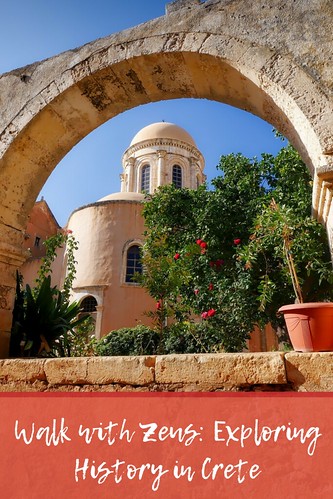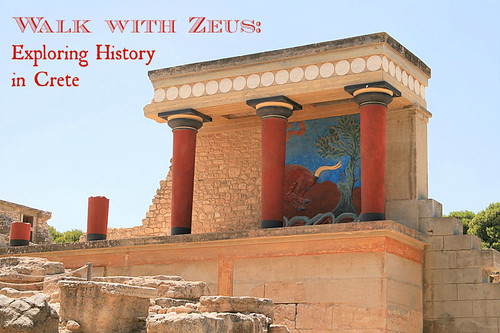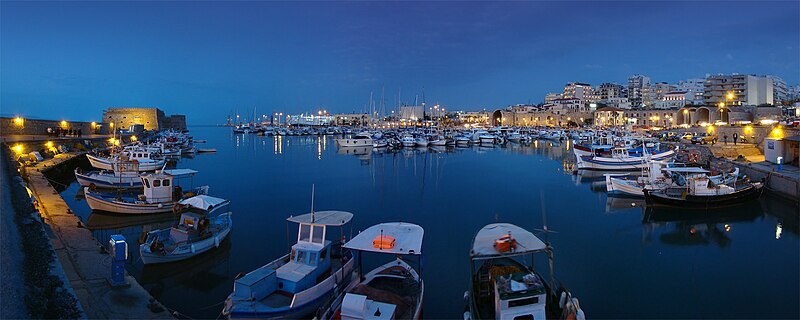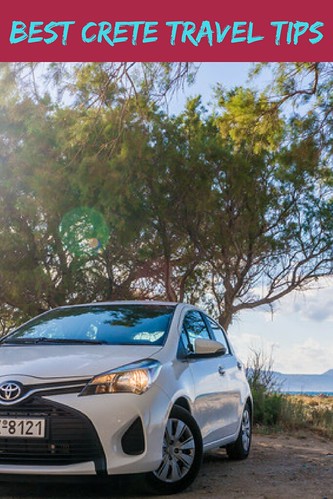The birthplace of Zeus, the home of the Minotaur, Daedalus’ labyrinth (and Ariadne’s clue), the launching place of Icarus – where are you? Why, Crete, of course!

The largest of all the Greek islands, Crete is one of the most beautiful – and historic – places in the world. Travelers come for the culture, history, beaches, warmth, famous Greek hospitality, delicious food, village life in the kafeneion (coffee shop), and festivals. And they return, again and again, for those same reasons. It’s as close as you can get to a deeply cultural paradise on earth.

Photo Wikimedia Commons: Wolfgang Sauber
If you want to walk in the footsteps of Zeus, and explore the rich history of Crete, here are ten interesting places to do so.

Photo Wikimedia commons: lapplaender, adapted by Wandering Educators
1. Heraklion Archaeological Museum (Iraklio, in Greek). Located in the town center, it is one of the largest and most important museums in Greece (and in Europe, for that matter). Artifacts from over 5,500 years of history are here – it is the best museum of Minoan culture. The first archaeological collection was started in 1883, and has grown exponentially since then. What will you see? Famous frescoes (including the Knossos Frescoes), pottery, jewelry, Linear A and B tablets, the Phaestos Disk, sarcophagi, vases, figurines, and even games. This should be the first top on your Crete history tour!
2. The Crete Historical Museum is also located in Heraklion. Here, you can see an overview of Cretan history, ceramics and sculptures, Byzantine art, modern and contemporary Cretan history, and excellent ethnographic collection, and a model of the city of Chandax, mid-17th century – right at the height of its power in the Venetian era. You’ll also see two paintings by El Greco, who was born and studied icon painting here in Heraklion.
3. Chania Archaeological Museum. Located in Chania, there is much history to delve into here! You can see pottery, carved stone, sculpture, metalwork, jewelry, mosaic floors, Minoan objects, and even a Turkish fountain, located in the courtyard. In this museum, you’ll discover historical facts of daily lives in Crete, including crafts, occupations, burial rites, and more.

Photo Wikimedia Commons: Sarah Murray
4. Maritime Museum of Crete. Located in Chania, you can find this museum by the enormous anchor located outside the door! This museum covers maritime history from antiquity to the Battle of Crete (1941). You’ll see wreck finds, maritime books, models of vessels, navigational instruments, and more.
5. The Historical Folk Museum of Rethymnon. This museum is located in a 17th century Venetian townhouse, and showcases much of historical life in Crete. You’ll see textiles, pottery, lacework, metalwork, weaving equipment, costumes, and more.
6.The Archaeological Museum of Agios Nikolaos. If you’re more into archaeological finds, this is the place for you! Displays range from the Neolithic (6000 BC) to Minoan (3000 BC) to Roman times (2nd century AD). The most famous item in the collection is the Athlete’s Skull, which dates from 1st century AD. It is crowned by a golden diadem of olive leaves. In his mouth? A silver coin to pay Charon. In this museum, you’ll also see finds from Minoan tombs, the Goddess of Myrtos vessel, and finds from the Minoan Palace of Malia.
7. The Sitia Archaeological Museum has a bit broader scope, with finds from all over Crete. You’ll see exhibits from the Minoan period, Zakros, Geometric and Archaic periods, and the Greco-Roman period. There are treasures from the Palace of Kato Zakros, Linear A tablets, the Kouros Statue from Palaikastro, relief tables, vases from a shipwreck (kept in salt water!), and a wreathed bull.
8. Knossos Palace. Although not a museum, per se, it’s a historical find that should definitely be on your list. This famous palace is located south of Heraklion. This was the symbol of Minoan civilization, and has had many incarnations. The first one was built at the end of the 2nd millennium BC, and was destroyed in 1700 BC. It was rebuilt and destroyed again in 1350 BC. This was the home of King Minos (and the center of Cretan power and civilization). What can you see here? Ruins – where you can use your imagination to make history come alive.
9. The Lychnostatis Cretan Open Air Museum. This museum aims to promote understanding and awareness of Cretan folk cultural heritage. As such, the exhibits include Cretan folk tradition and ethnology, nature and environment, and folk culture. There are many buildings (and gardens) in this open air museum, where you can meander around and imagine life so long ago. Visitors say visiting here is one of the best aspects of their travels in Crete.
10. The Idion Cave. While not a museum, per se, this is one of the most important sites in Crete. The birthplace of Zeus, this cave is on the highest mountain in Crete (Mt Ida). It is also an important major Greek temple. Now, you know history – always contested. Another cave vies for this same title – the Dikteon Cave, which is more beautiful than the Idion Cave, because of its many stalagmites and stalactites. This cave is found on the Lassithi Plateau, on Mt Dicte.

Cave of Dikteon. Wikimedia commons: Jerzy Strzelecki
Details for Visiting Crete:
Where to stay
Make it easy on yourself! Thomas Cook's Crete Holidays provides a variety of options for visiting Crete, including flights and accommodations, from all inclusive to self-catering.
How to get to Crete
You can fly in (Heraklion is the international airport, although there are two others).
You can take a ferry in from Piraeus, Thessaloniki, and the Cyclades.

Heraklion, Crete. Photo Wikimedia Commons: Tango7174
How to Get Around
There are many options for getting around. You can rent a car in Crete with Rental Centre Crete, take the bus, or ride a ferry!
What to eat
You’ll find much to love here, as Crete has a rich culinary tradition. Olive oil, honey, yogurt, and cheese are all produced locally. You’ll enjoy the Mediterranean diet of fresh vegetables, fruits, and fish. But you can also enjoy barbecued meats, gyros pitas (gyropitta) potatoes, dolmades, and especially wine and local spirits.
Locals eat late (around 10pm or later) at a local tavern. If you want to eat as the locals do, don’t ask for a menu – ask the waiter for the day’s specials.
Want to know more about Crete’s museums and history? There’s a full listing here:
http://www.explorecrete.com/archaeology/antiquities-crete.html
More on Linear A:
http://www.wanderingeducators.com/linear-and-me.html
Pin for later:

Note: this article was originally published in 2014 and updated in 2018
